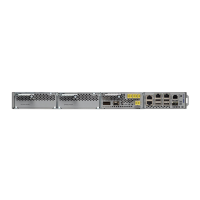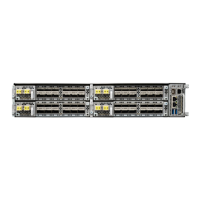2. If both nodes do not use the same Layer 2 settings, you will have to delete the incorrect termination and
recreate it. To delete it, click the termination and click Delete. To recreate it, refer to the Turn Up Node
chapter in the Configuration guide for the procedure.
3. If the nodes use PPP Layer 2, complete the Clear the RS-EOC Alarm, on page 381 procedure. If the alarm
does not clear, go to Step 7, on page 245.
4. If both nodes use the LAPD Layer 2 protocol but have different Mode settings, change the incorrect node
entry by clicking the correct setting radio button in the Edit MSDCC termination dialog box and clicking
OK.
5. If the Layer 2 protocol and Mode settings are correct, ensure that one node is using the Network role and
the other has the User role. If not (that is, if both have the same mode settings), correct the incorrect one
by clicking the correct radio button in the Edit MSDCC termination dialog box and clicking OK.
6. If the Layer 2, Mode, and Role settings are correct, compare the MTU settings for each node. If one is
incorrect, choose the correct value in the Edit MSDCC dialog box and click OK.
7. If all of the preceding settings are correct, ensure that OSI routers are enabled for the communications
channels at both ends by completing the following steps:
8. If the routers on both ends are enabled and the alarm still has not cleared, ensure that both ends of the
communications channel have a common MAA by completing the following steps:
DETAILED STEPS
Step 1 Ensure that both ends of the communication channel are using the correct Layer 2 protocol and settings (LAPD or PPP).
To do this, complete the following steps:
a) At the local node, in node view, click the Provisioning > Comm Channels >MSDCC tabs.
b) Click the row of the circuit. Click Edit.
c) In the Edit MSDCC termination dialog box, view and record the following selections: Layer 2 protocol (LAPD or
PPP); Mode radio button selection (AITS or UITS); Role radio button selection (Network or User); MTU value; T200
value, and T203 selections.
d) Click Cancel.
e) Log in to the remote node and follow the same steps, also recording the same information for this node.
Step 2 If both nodes do not use the same Layer 2 settings, you will have to delete the incorrect termination and recreate it. To
delete it, click the termination and click Delete. To recreate it, refer to the Turn Up Node chapter in the Configuration
guide for the procedure.
Step 3 If the nodes use PPP Layer 2, complete the Clear the RS-EOC Alarm, on page 381 procedure. If the alarm does not clear,
go to Step 7, on page 245.
Step 4 If both nodes use the LAPD Layer 2 protocol but have different Mode settings, change the incorrect node entry by clicking
the correct setting radio button in the Edit MSDCC termination dialog box and clicking OK.
Step 5 If the Layer 2 protocol and Mode settings are correct, ensure that one node is using the Network role and the other has
the User role. If not (that is, if both have the same mode settings), correct the incorrect one by clicking the correct radio
button in the Edit MSDCC termination dialog box and clicking OK.
Step 6 If the Layer 2, Mode, and Role settings are correct, compare the MTU settings for each node. If one is incorrect, choose
the correct value in the Edit MSDCC dialog box and click OK.
Step 7 If all of the preceding settings are correct, ensure that OSI routers are enabled for the communications channels at both
ends by completing the following steps:
a) Click Provisioning > OSI > Routers > Setup.
b) View the router entry under the Status column. If the status is Enabled, check the other end.
c) If the Status is Disabled, click the router entry and click Edit.
Cisco NCS 2000 series Troubleshooting Guide, Release 11.0
245
Alarm Troubleshooting
Clear the ISIS-ADJ-FAIL Alarm

